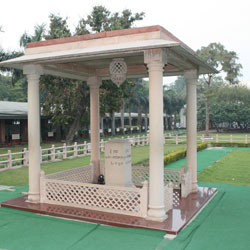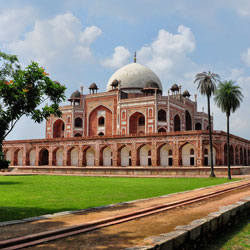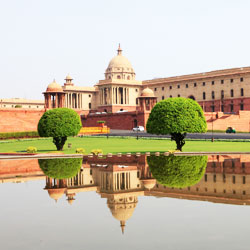
- 魅影直播
- Travel Packages
- Top Destination
-
Travel Attraction
By Category
Top Attraction

- Travel Agents
- Car Rentals
- Hotels

All the people who were given a free country and were privileged enough not to have fought for their freedom might consider themselves as lucky but they don’t realize what they have missed. They have missed the pious opportunity of being under the leadership of one of the greatest leaders of India, Mahatma Gandhi who was also called the father of India’s freedom struggle. Life has given all those unfortunate people a second chance to relive the aura which Gandhi created with his presence by visiting The National Gandhi Museum or Gandhi Memorial Museum. This museum located in the heart of India i.e. New Delhi throws light on the entire life time of Gandhiji and his principles. The museum was initially opened in Mumbai and then faced several relocations, and was finally established at Raj Ghat, New Delhi in 1961. It was inaugurated shortly after Gandhi’s assassination in 1948.The groundwork for the establishment of the museum started immediately after his assassination when the collectors started searching and gathering for things of importance to Mahatma Gandhi. The initial items which were taken to the museum were his personal items, newspapers and books related to Gandhi and were originally stored in Mumbai. However, in 1951 the items were relocated to a building near the Kota house in New Delhi. Again in 1957 the items were stored in big mansion.Finally, once again for the last time the items underwent relocation when they found the most suitable place for them near Gandhiji’s Samadhi at Raj Ghat at New Delhi. The items were then opened for the visitors in 1961 on the occasion of the 13th anniversary of Mahatma Gandhi’s assassination; it was the time when Dr. Rajendra Prasad was the President of India.LibraryThe library at the Gandhi Museum serves the dual purpose of enriching ones knowledge about Gandhiji’s work and permits one to do general studies as well. The book section is divided into two, one boasting the books written by or about Gandhi and the other which caters to other subject matters. At present there is a wide collection of 35000 books or documents and also 2000 journals available in both English and Hindi languages, illuminating the life Gandhi that are stored at the museum. In addition to books it also stores a large number of items and personal items of Gandhiji. Some of the most important items available to display are Satyagraha woodcut by Willemia Muller Ogterop, Gandhi's walking sticks which he used to carry everywhere, the shawl and dhoti which he was wearing at the time of his assassination, a bullet which took our most loved leader to another world and also most importantly his urn.A trip to this museum is worth a million and also a need of the hour, hence it is a must.
Explore More
About The Humayun Tomb The Humayun Tomb, located in New Delhi, India, is a magnificent piece of Mughal architecture and is a UNESCO World Heritage Site. It is the tomb of the Mughal Emperor Humayun and was commissioned by his first wife, Empress Bega Begum, in 1569. The tomb is a stunning example of Persian and Indian architectural styles and is surrounded by beautiful gardens. Timings Of Humayun Tomb The Humayun Tomb is open every day of the week from sunrise to sunset. It is recommended to visit early in the morning to avoid the crowds and the heat. Entry Fee The entry fee for Indian nationals is Rs. 30 and for foreign tourists, it is Rs. 500. There is no entry fee for children under 15 years of age. Required Time And Restricted Items It takes about 1-2 hours to explore the Humayun Tomb complex. Visitors are not allowed to bring food, drinks, or pets inside the tomb premises. Smoking is also prohibited. Architecture of Humayun Tomb The Humayun Tomb is a masterpiece of Mughal architecture, with its red sandstone and white marble structure. The tomb stands on a raised platform and is topped with a stunning double dome. The intricate carvings, geometric patterns, and calligraphy on the walls and ceilings are breathtaking. Best Time To Visit The best time to visit the Humayun Tomb is during the winter months, from October to March, when the weather is pleasant. Early mornings and late afternoons are ideal for exploring the tomb and its surroundings. How To Reach The Humayun Tomb is easily accessible by public transportation. The nearest metro station is JLN Stadium, which is located on the Violet Line. Visitors can also reach the tomb by taking a bus or hiring a taxi or auto-rickshaw. History Of Humayun Tomb The Humayun Tomb was built to honor the Mughal Emperor Humayun, who ruled India from 1530 to 1540 and again from 1555 to 1556. The tomb was completed in 1572 and became the first garden-tomb on the Indian subcontinent. It served as a prototype for the Taj Mahal in Agra. Inside Humayun Tomb Inside the Humayun Tomb complex, visitors can explore the main tomb chamber, the surrounding gardens, and other smaller tombs and structures. The main tomb chamber houses the cenotaph of Emperor Humayun, while his actual grave is located in a chamber below. Traveling Tips It is advisable to wear comfortable shoes and clothing while visiting the Humayun Tomb, as there is a fair amount of walking involved. Carry a water bottle and sunscreen to stay hydrated and protected from the sun. It is also recommended to hire a guide to learn more about the history and significance of the tomb. Hotels Near Humayun Tomb There are several hotels near the Humayun Tomb that offer comfortable accommodation for visitors. Some of the prominent hotels include The Lodhi, The Claridges, and The Oberoi, New Delhi. Nearby Tourist Spots of Humayun Tomb There are several other tourist attractions near the Humayun Tomb that visitors can explore, such as the Qutub Minar, India Gate, Lotus Temple, and Akshardham Temple. These sites offer a glimpse into India's rich history and culture.
Explore More
About The Tughlaqabad Fort The Tughlaqabad Fort, located in New Delhi, is a historic fortress built by Ghiyas-ud-din Tughlaq, the founder of the Tughlaq Dynasty, in the 14th century. The fort served as a symbol of the might and power of the Tughlaq rulers during their reign in India. The massive structure covers an area of around 6.5 km and is known for its impressive architecture and strategic location. Timings Of Tughlaqabad Fort The Tughlaqabad Fort is open to visitors from 7:00 AM to 5:00 PM on all days of the week. Entry Fee The entry fee for Indian nationals is INR 5 per person, while for foreign tourists, the fee is INR 100 per person. Required time And Restricted Items Visitors usually spend around 1-2 hours exploring the fort and its surroundings. Some of the restricted items at the fort include weapons, alcohol, and pets. Architecture Of Tughlaqabad Fort The architecture of Tughlaqabad Fort is a unique blend of Islamic and Indian styles. The fort features massive walls, bastions, and stepped wells. The strategic layout of the fort reflects the military prowess and defensive strategies of the Tughlaq rulers. Best Time To Visit The best time to visit Tughlaqabad Fort is during the winter months from October to March when the weather is pleasant for sightseeing and exploring the historical site. How To Reach The Tughlaqabad Fort is easily accessible by road. Visitors can hire a taxi, auto-rickshaw, or take a bus to reach the fort from different parts of Delhi. History Of Tughlaqabad Fort The construction of Tughlaqabad Fort began in 1321 under the reign of Ghiyas-ud-din Tughlaq. The fort was designed as a massive citadel to protect the city of Tughlaqabad from invasions. However, the fort's construction faced numerous challenges, and it was abandoned soon after the death of Ghiyas-ud-din Tughlaq. Inside Tughlaqabad Fort Inside the fort, visitors can explore the ruins of the massive walls, bastions, underground chambers, and the remains of the royal palace. The fort offers panoramic views of the surrounding landscape and is popular among history buffs and architecture enthusiasts. Traveling Tips It is advisable to wear comfortable footwear and carry drinking water while exploring the fort. Visitors can also hire a guide at the entrance to learn more about the history and significance of Tughlaqabad Fort. Hotels Near Tughlaqabad Fort Some of the hotels near Tughlaqabad Fort include: 1. The Suryaa New Delhi 2. Hotel Evoke Lifestyle 3. OYO Flagship 72632 Ashram Metro 4. Hotel Swagat Palace 5. FabHotel Lakshya Nearby Tourist Spots of Tughlaqabad Fort Some of the nearby tourist spots of Tughlaqabad Fort include: 1. Lotus Temple 2. Qutub Minar 3. Humayun鈥檚 Tomb 4. India Gate 5. Akshardham Temple
Explore More
The construction of Rashtrapati Bhawan covers an area of 200,000 square feet nearly a massive number of 700 million bricks and three million cubic feet of stone has been put to use, leaving no space for even a minute particle of steel. Indian architecture comes with a package of water feature hence, variety of circular stone basins were added. Giving a traditional touch there is also a chajja replacing classical architecture’s frieze, prevents harsh sunlight from the windows and also shields them during the rainy season. Chuttris on the roofline erases the flatness of the roofline as it is not covered by dome. Several idols of elephants and fountains sculptures of cobras have been installed further illuminating the Indian theme. Inspired from the Rajasthani style jaalis, enhancing red sandstone has also been installed. The posterior of the palace has 12 unevenly separated huge columns with Delhi order capitals. It also has an unusual coupling of acanthus leaves and bells that are found in Hindu temples, however, the bells were silent which meant there is no end to the end of British rule in India. To glorify his personal resemblance to the house, Lutyens added several bijou personal elements like an area of his in the garden walls and two windows which seemed to resemble the glasses which he wore. DomeIn the middle stands a perfect example of Indian and British fusion, which is exhibiting copper work and mastered over a drum. This seems different from the rest of the building owing to its height, which is nearly twice of the rest. It is situated right in the middle point at which the diagonals of the four corners meet. An enthralling fact is that the building took 17 years to complete. However, eighteen years later India became independent. The Mughal gardens are accessible for visiting by the general Public only during the Udyanotsav during the February-March. What draws maximum attention are the 5000 Tulips blossoming in bright o red, orange and yellow colors mixed with red and white as well. Two restorations were made to the Rashtrapati Bhawan out of which one was made by Sunita Kohli in 1985 which took 4 years to complete and the other was done in 2010 which also involved Sunita Kohli along with Charles Correa. It was decided in the Delhi Durbar of 1911 that the capital of India would be shifted from Calcutta to Delhi. Thus was born the city of Delhi, designed by the great architect Edwin Lutyens, along with Herbert Baker. It took approximately 20 years and 15 million pounds to build New Delhi. Built as the Viceral Lodge, Delhi Rashtrapati Bhawan comprises of four floors and 340 rooms. Now known as the President House of New Delhi, it is spread over an area of approximately 200,000-sq-feet. It took 18 years to construct this building and on the on the 18th year of its completion, India became independent. The Jaipur Column, a gift from the Maharaja of Jaipur, stands at a height of 145 m in the middle of the main court in front of the Rashtrapati Bhavan. Another one of the impressive features of the Delhi Rashtrapati Bhawan comprises of the outstandingly beautiful Mughal Gardens. Then, at the base of the building, is a spacious square, known as the Vijay Chowk. The massive neo-Buddhist copper dome of the President House of New Delhi is splendid and can be seen even from a distance of a kilometer. Underneath this fabulous dome is the circular Durbar Hall, housing the Viceroy's throne, measuring almost 22.8 m in diameter. Before the National Museum was completed, it served as a museum for a number of years. All the official ceremonies such as the swearing in of the Prime Minister, the Cabinet and the Members of Parliament, etc., take place in this hall only. Also, the Arjuna Awards for Excellence are awarded by the President from here itself. On the ground floor of the Rashtrapati Bhavan are a number of state apartments. Then, there is the State Drawing Room, State Ballroom, State Dining Room and a number of other such rooms inside the building. The Delhi Rashtrapati Bhawan consists of 54 bedrooms, along with additional accommodation for guests.
Explore More
National Gallery of Modern Art
Located very close to India Gate, this building was earlier the residential palace of the Maharaja of Jaipur. It exhibits around 4,000 paintings, graphics, and sculptures of modern artists. The gallery arranges special exhibitions for those who wish to exhibit their works. The National Gallery of Modern Art was inaugurated on March 29, 1954 at Jaipur House, New Delhi. It is the only institution of it's kind in India, run and administered by the Government of India. It represents the evolution of the changing art forms through the passage of more than a hundred years starting from about 1857. In The stately Jaipur House (location for the National Gallery of Modern Art) are on display paintings, sculpture and graphic art dating from the mid 19th century to the present day. The school is represented by Abanindranath Tagore, especially his Advent of the Rainy Season, Twilight and Landscape: Nandalal Bose, Ramkumar Kinkar, Rabindranash Tagore, Binod Behari Mukherjee among others. The foremost responsibility of the National Gallery of Modern Art is to ensure quality and set and maintain a standard of excellence that pervades all it's activities. Despite numerous handicaps modern Indian artists have made impressive progress, especially in the last two decades.
Explore MoreCultural Triangle Delights - Jaipur - Delhi - Agra Tour
6 Days/ 5 Night
New Delhi - Jaipur - Agra
3 Night - 4 Days Agra Tour From Delhi
4 Days/ 3 Night
New Delhi - Agra
4 Nights - 5 Days Golden Triangle Tour Package
5 Days/ 4 Night
New Delhi - Jaipur - Agra
Religious - Spiritual Tour Of Old New Delhi
1 Day
New Delhi